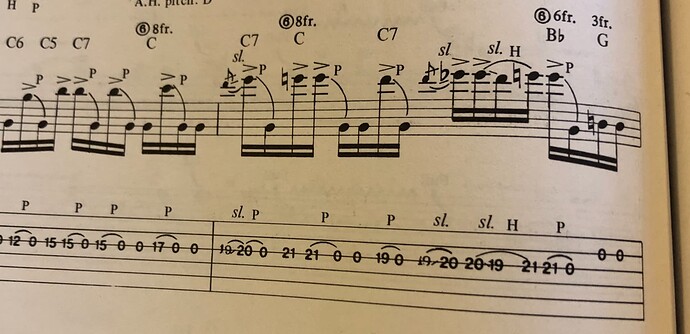These two comments together are very interesting to me, and kind of dovetail into an unrelated question of mine I’ve had for a while related to Satriani’s “Summer Song” solo, particularly the first lead break.
I’m awful at learning other people’s solos for some reason, probab;y because I don’t often try, but I’ve picked this one up periodically over the years, and there’s one passage in particular from the official transcriptionbook (which I own) that always threw me when I was younger but made me think a bit when I picked it up recently.
I hope this is ok to share an excerpt, purely for discussion and analysis:
This is the bit right around the two minute mark of the studio recording.
When I first picked it up my thought was it was, well, notated as written, and Satriani was doing these elabprate little half step slides and then this crazy fast 19/20 then 20/19 slide in the middle of an already blisteringly fast solo, which was luducrous.
More recently, I picked this back up and had a change of mindset, I guess, about this - that it was probaby notated as heard rather than written, that Satch wasn’t carefully sliding from the 19th to the 20th and then back but that this was probably something he wrote with a bit of chromaticism in mind (in G Dorian this is a chromatic walk-up from the 5th to the major 6th and against the C7 that’s sounding gives uyou some m3/M3 bluesy color) but those slides were likely not intentional but was sort of more an artifact of the performance, and playing them however you coudl get them out - maybe just sliding into the 20th from somewhere below on the first, and then in the second just do it as a pull off and hit on thing rather than focusing on the exact fingering, and worry more about the contour of the notes than some of his grace note accents, is probably the way to go.
So, all that said… is it fair to look at a transcription in this way, that your focus is documenting what actually happened rather than what the part was probably written to sound like, and that sometimes accepting that some of these oddities are probably happy accidents or artifacts of even a great player trying to play a challenging part and going with a performance that had the right vibe even if it wasn’t textbook-clean, and that’s kind of what you’re getting at with “I’m confident this is accurate/I wouldn’t try to learn it as written”?
![]()







